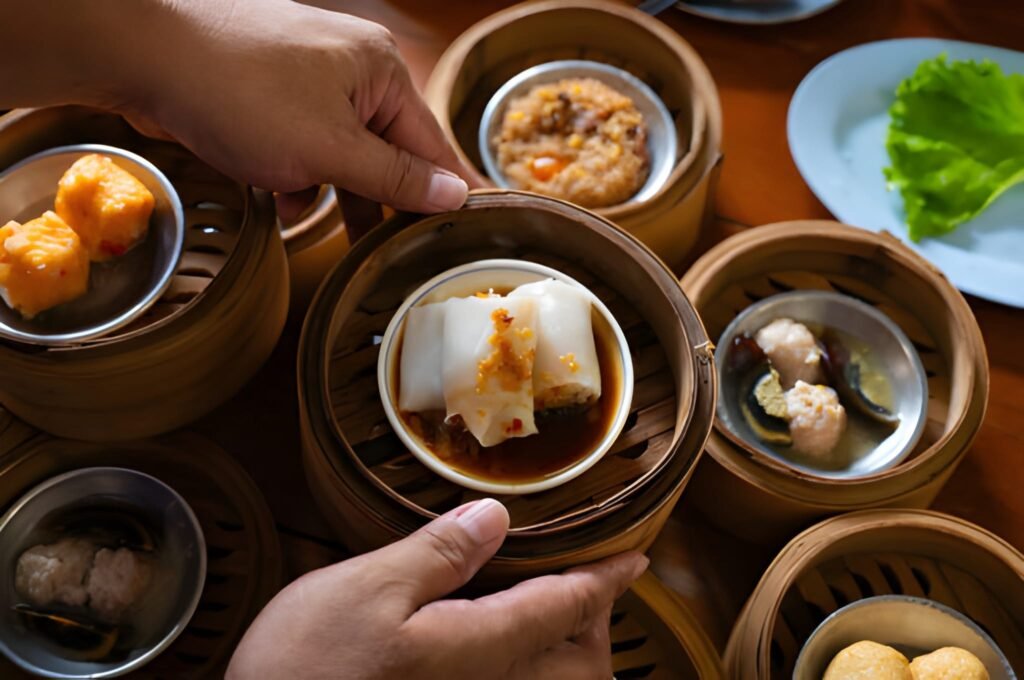Introduction: A Timeless Steam Rising
Picture yourself in a bustling Asian street market just before noon. Vendors lift the lids of stacked bamboo baskets, and a cloud of fragrant steam escapes soft buns, dumplings, and sticky rice hidden inside. The smell is earthy, warm, and ancient. This is bamboo steaming traditional cooking, a method that has outlived empires, generations, and countless food trends.
For many, steaming in bamboo isn’t just a cooking style; it’s an inheritance. A quiet reminder that some of the world’s best meals don’t need shiny gadgets, but rather a woven basket, boiling water, and patience.
Why Bamboo Steaming Matters in Traditional Cooking
Cooking methods are more than just techniques; they tell us how people lived, traded, and celebrated. Bamboo steaming is deeply tied to Asia’s food identity, especially in China, Southeast Asia, and Japan.
-
In China, bamboo steamers are tied to dim sum culture, where sharing steamed dumplings is a social ritual.
-
In Thailand, sticky rice steaming baskets are still daily tools.
-
In Japan, steaming fish and vegetables in bamboo containers reflects harmony with nature.
What makes bamboo steaming traditional? It’s simple yet effective: bamboo fibers allow steam to circulate evenly, while the basket absorbs excess moisture, keeping food delicate and flavorful. It’s an eco-friendly, health-conscious, and culturally rich way to cook.
A Cultural Journey Through Bamboo Steaming
Imagine grinding wheat on a stone mill centuries ago, or pounding rice by hand. In the same way, using bamboo steamers has been an ordinary but essential act of survival, evolving into a cultural icon.
China – The Dim Sum Tradition
Historical records suggest bamboo steaming dates back over 2,000 years, during the Han Dynasty. Bamboo was cheap, abundant, and strong—ideal for making baskets that doubled as cooking tools. Today, dim sum restaurants in Hong Kong and Guangzhou still rely on stacks of bamboo baskets to deliver bite-sized treasures.
Thailand – Sticky Rice Ritual
If you’ve traveled in rural Thailand, you’ve likely seen woven conical baskets perched over steaming pots. Sticky rice is more than food—it’s the heart of the meal. Bamboo steaming ensures the grains stay separate, tender, and fragrant.
Japan – Harmony with Simplicity
In Japanese cuisine, steaming in bamboo expresses the philosophy of wabi-sabi—finding beauty in simplicity. Steamed vegetables, fish, and delicate dumplings are often served in bamboo containers, making the cooking vessel part of the presentation.
How Bamboo Steaming Works
At first glance, a bamboo basket may look fragile, but its engineering is clever. Thin bamboo strips are woven into layers that sit snugly above a pot of boiling water.
-
Circulation: Steam rises and penetrates evenly through the slats.
-
Absorption: The bamboo absorbs excess moisture, preventing soggy food.
-
Stackability: Multiple baskets can be layered, saving fuel and space.
This method is healthier because it doesn’t need oils or fats. Foods retain nutrients, vibrant colors, and natural aromas. You might never guess that such a humble tool could achieve what modern appliances still try to replicate.
Table: Why Bamboo Steaming Survives the Centuries
| Feature | Bamboo Steaming | Metal / Electric Steamers | Frying / Baking |
|---|---|---|---|
| Flavor | Light, earthy, aromatic | Neutral, sometimes metallic | Rich, but often oily |
| Texture | Moist, tender, non-greasy | Moist but sometimes soggy | Crispy or dry |
| Health | No oil needed, nutrient retention | Low-oil, but less natural | Often high in fat |
| Eco-Impact | Biodegradable, renewable | Metal/plastic waste | High energy/fuel use |
| Cultural Role | Symbol of tradition & heritage | Modern convenience | Entertainment, less ritual |
The Expert Lens: Authority Behind Bamboo Steaming
According to the Smithsonian Institution, bamboo has been a “cultural super material” in Asia for millennia, used for tools, homes, and food vessels. The National Geographic Society has highlighted bamboo cooking baskets as a sustainable alternative to plastic or metal.
Statista data shows that in China alone, over 350 million bamboo steamers are still sold annually, underscoring both tradition and modern demand. Even culinary schools like Le Cordon Bleu teach bamboo steaming as part of world gastronomy, linking ancient methods to professional kitchens.
Living Tradition: Experience and Anecdotes
When I first tried steaming dumplings in a bamboo basket, I worried they’d stick or fall apart. But the moment I lifted the lid, I saw soft buns glistening like pearls, perfectly cooked. The aroma wasn’t just from the food—it came from the bamboo itself, adding a whisper of sweetness.
In my hometown, an elderly neighbor still steams fish with ginger and scallions in bamboo. She says, “Metal gives you food. Bamboo gives you flavor.” That stuck with me.
Step-by-Step Guide to Using Bamboo Steamers
-
Prep the Basket: Line it with parchment, banana leaves, or cabbage to prevent sticking.
-
Set the Steamer: Place it over a wok or pot with a couple of inches of boiling water.
-
Stack Smart: Layer foods by cooking time, vegetables on top, buns or dumplings below.
-
Control Steam: Keep a steady boil but not too fierce, or the water may touch the food.
-
Serve ina Basket: Many Asian households bring the bamboo basket straight to the table.
It felt like stepping back in time when I tried this myself, minimal tools, maximum results.
Why Bamboo Steaming Is Still Relevant Today
-
Health-conscious cooking is trending, and steaming is one of the healthiest methods.
-
Eco-friendly living: Bamboo is renewable and biodegradable.
-
Cultural revival: Younger generations rediscover traditional cooking to connect with heritage.
-
Global appeal: Bamboo steaming has reached Western kitchens thanks to the rise of dim sum, bao buns, and Thai sticky rice abroad.
When you step back, it feels like bamboo steaming isn’t just surviving—it’s thriving.
FAQs on Bamboo Steaming Traditional Cooking
Q1: Does bamboo steaming make food taste different?
Yes, bamboo adds a subtle, earthy aroma you won’t get from metal or electric steamers.
Q2: Can bamboo baskets be reused?
Absolutely. With proper cleaning and drying, a bamboo steamer can last years.
Q3: Is bamboo steaming safe for all types of food?
Yes—vegetables, fish, dumplings, buns, and even desserts like sponge cakes can be steamed.
Q4: Is it worth buying a bamboo steamer today?
Definitely. It’s affordable, eco-friendly, and adds authenticity to cooking Asian dishes.
Final Thoughts: What Bamboo Steam Reminds Us
Bamboo steaming isn’t just a technique; it’s a reminder of resilience. From royal courts in ancient China to modern street markets, this humble basket carries heritage in its woven strands.
Here’s what this really means: food culture doesn’t always need reinvention. Sometimes, the oldest tools—like a bamboo steamer are still the most perfect.



